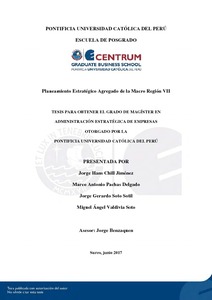| dc.contributor.advisor | Benzaquen de las Casas, Jorge Benny | |
| dc.contributor.author | Chill Jiménez, Jorge Hans | es_ES |
| dc.contributor.author | Pachas Delgado, Marco Antonio | es_ES |
| dc.contributor.author | Soto Sotil, Jorge Gerardo | es_ES |
| dc.contributor.author | Valdivia Soto, Miguel Ángel | es_ES |
| dc.date.accessioned | 2017-07-06T19:34:37Z | |
| dc.date.available | 2017-07-06T19:34:37Z | |
| dc.date.created | 2017 | |
| dc.date.issued | 2017-07-06 | |
| dc.identifier.uri | http://hdl.handle.net/20.500.12404/8938 | |
| dc.description.abstract | El Plan Estratégico Agregado para la macro región siete, que está conformada por los
departamentos de Ayacucho, Huancavelica e Ica, se ha realizado tomando en cuenta el
modelo secuencial del Proceso Estratégico hecho por el Dr. Fernando D´Alessio, donde se
plantean las estrategias que permitirán el crecimiento sostenible de los sectores económicos
de la macro región, utilizando de manera eficiente los recursos naturales y planteando nuevas
actividades económicas que permitirá el desarrollo socio-económico de su población, para
ello se realizó un análisis de su situación actual, en la cual se determinó las fortalezas y
debilidades así como sus oportunidades y amenazas. La macro región siete cuenta con las tres
regiones naturales del país, lo que le otorga una ventaja comparativa con respecto a otras
macro regiones y será explotada respetando la sostenibilidad de los recursos. Así, en el
análisis elaborado, se está planteando el desarrollo del primer circuito turístico que integre a
toda la macro región, para ello se incentivará el turismo vivencial y eco turismo, que
permitirá a los pobladores de las zonas de influencia obtener ingresos por los servicios
prestados a los visitantes.
El Plan Estratégico de la macro región siete se basa en cuatro pilares fundamentales
que permitirán su desarrollo y crecimiento, estos son: (a) la educación, su posición
competitiva está ligeramente debajo del promedio nacional pero es muy factible de revertir a
mediano plazo, (b) el turismo, para potenciarlo se mejoraran las redes viales de conexión, con
la ayuda del sector privado, obras por impuestos, etc., (c) la agro exportación, que se
potenciará con la reducción de costos logísticos, y (d) la utilización de energías renovables,
para ello los objetivos de largo plazo planteados permitirán elevar la competitividad de la
macro región siete convirtiéndola en el referente del país | es_ES |
| dc.description.abstract | The Added Strategic Plan for the seven macro region, which is made up of the
departments of Ayacucho, Huancavelica and Ica, has been made taking into account the
sequential model of the Strategic Process by Dr. Fernando D'Alessio, where strategies arise
that will enable sustainable growth of economic sectors of the macro region, efficiently using
natural resources and raising new economic activities that will enable the socio-economic
development of its people, to do an analysis of their current situation was conducted in which
the strengths and weaknesses as well as its opportunities and threats was determined. The
seven macro region has three natural regions of the country, which gives it a comparative
advantage over other macro regions and will be exploited respecting the sustainability of
resources. Thus, in the analysis prepared, it is considering the development of the first tourist
circuit that integrates the entire macro region, for which the experiential tourism and ecotourism,
which will allow the inhabitants of the areas of influence monetizing services will be
encouraged provided to visitors.
The Strategic Plan of the seven macro region is based on four pillars that allow
development and growth, these are: (a) education, its competitive position is slightly below
the national average but is very likely to reverse in the medium term, ( b) tourism, to enhance
it road networks connecting improve, with the help of the private sector, tax works, etc., (c)
agro export, which will be enhanced by reducing logistics costs, and (d) the use of renewable
energies, for this long-term goals raised, will enable increase the competitiveness of the seven
macro region making it the benchmark in the country | es_ES |
| dc.language.iso | spa | es_ES |
| dc.publisher | Pontificia Universidad Católica del Perú | es_ES |
| dc.rights | info:eu-repo/semantics/openAccess | es_ES |
| dc.rights.uri | http://creativecommons.org/licenses/by-nc-nd/2.5/pe/ | * |
| dc.subject | Desarrollo regional -- Perú | es_ES |
| dc.subject | Planificación regional -- Perú | es_ES |
| dc.subject | Planificación estratégica | es_ES |
| dc.title | Planeamiento estratégico agregado de la macro región VII | es_ES |
| dc.type | info:eu-repo/semantics/masterThesis | es_ES |
| thesis.degree.name | Maestro en Administración Estratégica de Empresas | es_ES |
| thesis.degree.level | Maestría | es_ES |
| thesis.degree.grantor | Pontificia Universidad Católica del Perú. CENTRUM | es_ES |
| thesis.degree.discipline | Administración Estratégica de Empresas | es_ES |
| renati.advisor.dni | 42800984 | |
| renati.advisor.orcid | https://orcid.org/0000-0001-8098-6401 | es_ES |
| renati.discipline | 413307 | es_ES |
| renati.level | https://purl.org/pe-repo/renati/level#maestro | es_ES |
| renati.type | https://purl.org/pe-repo/renati/type#tesis | es_ES |
| dc.publisher.country | PE | es_ES |
| dc.subject.ocde | https://purl.org/pe-repo/ocde/ford#5.02.04 | es_ES |






